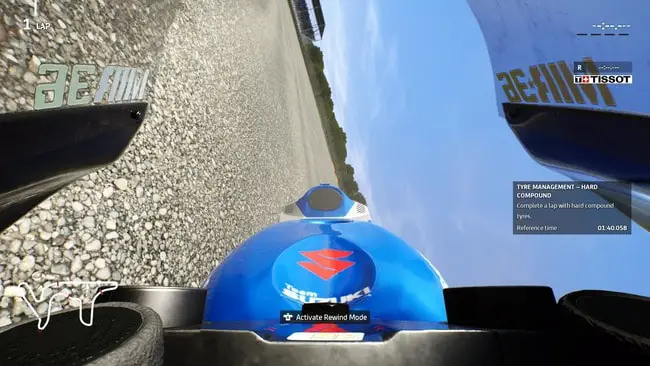There’s no escaping the fact that the MotoGP games are difficult for first time players, as they have a totally different handling model to 4 wheel racing games. Brand new players will find themselves constantly crashing the bike in the first few days/weeks of playing the game, as it’s such a different muscle memory that needs to be built.
It’s true that a lot of players simply get too annoyed and frustrated when playing these games and turn them off before really mastering them. Which is a shame because I think they’re great fun once you do get past the steep learning curve and start to get more consistent.
Therefore, I wanted to put together a help guide based on my own experience playing the newer editions of the game, with some broad, overarching tips to make learning these games easier if you’re currently finding them too difficult and annoying/frustrating.
Most of the tips in this guide do apply in some way to all the MotoGP games as they mostly have a similarly difficult learning curve if you’re not used to them.
But they’re especially geared towards the last few editions of the game – MotoGP 21, MotoGP 22 and MotoGP 23 – which have been especially hard compared to previous games. The game I’ve most recently been playing on – MotoGP 22 – is probably the hardest of all, but I’ve still got much better on this game applying these tips, so hopefully they help you out as well.
Let’s get started.
Tip #1 – Do The Tutorials If Available
There’s a great tutorial feature that’s been in the MotoGP games since 2021 that really helps newer players to learn the handling/physics and features of the game in a progressive way. It’s highly recommended that new players do this first rather than jumping straight into racing against the AI in custom races/career mode.
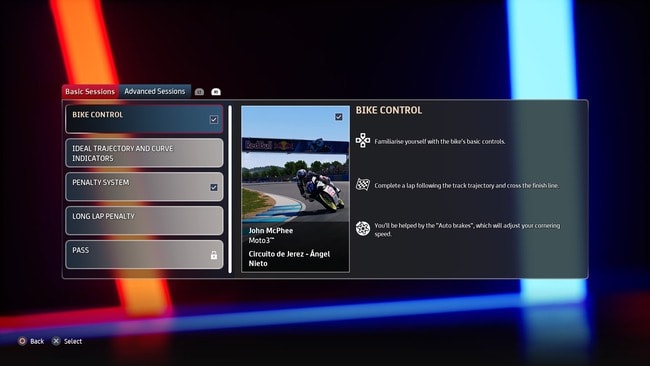
They progress you up from the Moto3 bikes to Moto2 and then the MotoGP bikes, so you can see the difference in handling and pick the class that best suits your current skill level to use in game modes. And they slowly introduce you to the game’s features so instead of being overwhelmed with everything all at once, you learn bit by bit how it all works and also get better with the handling naturally as you progress through the tutorials.
Trust me, spend a few hours at least (I spent a few days) on this mode, and you’ll get your head around the handling and game features much more easily and will be much better prepared to play other game modes.
Tip #2 – Get The Correct Assists Turned On
I don’t think there’s any realistic way you can start playing these MotoGP games fresh and learn with all the Riding Aids or assists turned off, without just annoying yourself off the game. Even for higher level sim racers who are good at other racing games. It’s too different to get used to right away and you realistically need at least some of (and I would argue, most of) the assists turned on to make it easier.
Find the Riding Aids menu and be sure to enable the assists you need:
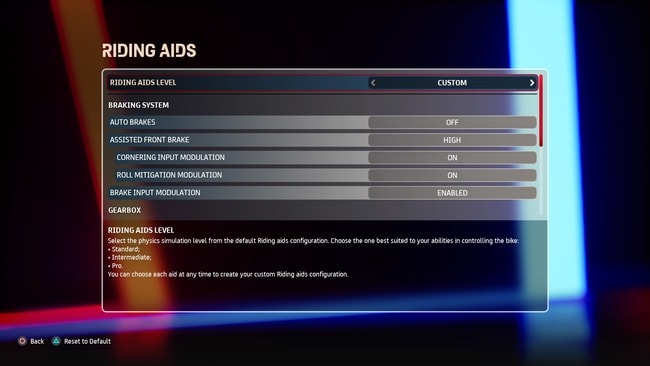
Here are the crucial assists to get enabled right away to make the handling easier:
- Auto Brakes – Off
- Assisted Front Brake – High or Moderate
-
- Cornering Input Modulation – On or Moderate
- Roll Mitigation Modulation – On or Moderate
-
- Brake Input Modulation – Enabled
- Transmission – Semi-Automatic
- Manual Start Management – Off (easier) or On (harder – personal preference)
- Electronics – Assisted
- Acceleration Input Modulation – Enabled
- Cornering Input Modulation (Steering) – Enabled
- Off Track Aid – On
- Ride Height Device – Semi Automatic
If you want to make it really easy in the very early days, you can also enable the Auto Brakes assist which does literally ALL the braking for you so you only really have to worry about the leaning/turning, but this really slows you down and it’s advised to turn it off once you start getting better
And then some specific peripheral game settings you’re advised to toggle on when learning the game:
- Rewind/Flashback – definitely need this on to reverse mistakes and get another shot.
- Ideal Trajectory (racing line) – enable when learning the tracks.
- Bike Recovery – Disabled is the easier option as it automatically re-spawns you on the bike if you fall off.
- Tyre/Fuel Consumption – Better to turn off for first few races so you can just concentrate on racing the AI and lapping the circuits consistently.
See our full assists guide for ’22 (also applies to other recent games) for more detailed settings recommendations. But these are the main ones to enable to make the games easier.
Tip #3 – Learn The Correct Braking/Turning Technique
Another thing that most newer players find too hard when starting out on these games is they simply can’t make the corners properly and keep over-running/overshooting and falling off.
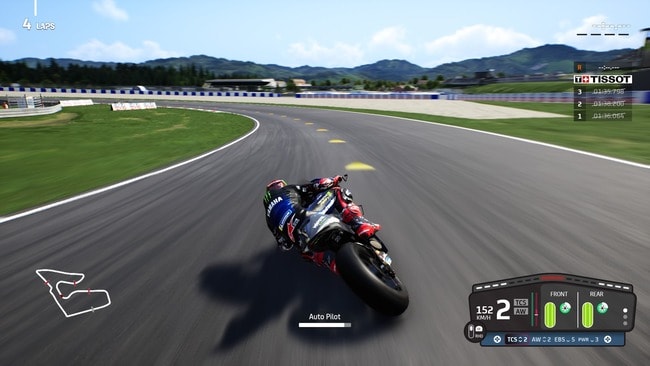
The braking and turning physics are totally different for the MotoGP games than other racing games, so any previous muscle memory you have from racing 4 wheel cars needs to pretty much be discarded and a new memory built.
Firstly, you need to brake and lean the bike much sooner than other racing games, in a way that will feel totally weird and alien if you’re used to F1 games for example.
And then there’s a specific method to the braking that also needs to be mastered. Here are some key pointers:
- Get most of your braking done in a straight line, when the bike is upright (not leaning).
- Start braking a long way before the corner after medium/long straights (turn the Ideal Trajectory on to give you an idea when).
- Some of the games have an input to apply both the front and rear brake. Other games from ’22 onwards have front and rear brake as separate inputs (in these cases, front brake is usually dominant, with rear brake as an optional complement).
- Apply the front brake smoothly but firmly, and add the rear brake for more stopping power if desired. Rear brake is also useful when making the corner but running a bit wide, to get the bike leaned in more.
- Once you’ve scrubbed off enough speed to make the corner, come off the brakes and start leaning the bike into the corner (again, you need to start this much sooner than with 4 wheel cars).
- Once the bike is past the apex, start easing back on the accelerator again, but not going full power until the bike is fully upright again.
- When another corner follows soon or immediately after, no accelerator (or just a tiny dab) is needed, before you need to start braking/leaning again.
- For “esses” sections (eg. Silverstone, Texas), you need to get into a rhythm of what’s coming next and literally as soon as you hit one apex, immediately leaning over ready to hit the next apex. There isn’t much time to rest or margin for error.
See our full guide on braking properly on MotoGP 22 (general advice applies to all MotoGP games) for more on the correct basic braking/cornering technique, plus more advanced methods you can apply once you’re used to the handling.
Tip #4 – Use A Stable, Easy To Control Bike Setup
This is another little hack for the MotoGP games that can make a difference. The default setup you’re given on these games does feel OK sometimes, but it’s not great. It can be fine for more experienced players, but it’s not really great for building confidence for newer players.
It’s better to create a custom setup that emphasises stability over raw pace, to make the game easier in the early stages.
See the excellent generic setup for MotoGP 22 I just found, which feels really stable and massively increased my confidence with the handling. For the very “understeery” MotoGP 23 handling model, see this starter setup that reduces this annoying understeer and makes the game easier and more fun to play.
You can also use the Race Engineer options from the bike setup menu to build a custom setup by telling the engineer what’s wrong with the current handling and what you want less/more of. Again, when learning these games it’s advised to seek setups which feel easy and comfortable to ride, rather than setups which might be potentially fast but harder to be consistent with.
There are some players who are sceptical about the idea of bike setups and whether they make a difference or not. But in my experience so far, some setups definitely do have a more stable and “planted” feel that makes it easier to lap circuits more consistently and get confident with the handling more quickly.
More specifically, it’s stability under leaning and braking that does seem really important when you want to get more consistent. Use a setup that gives you this, and it makes the games a lot easier to learn.
Tip #5 – Restrain Yourself On The Accelerator
This is more of a mindset tip that I’ve found crucial coming over from primarily playing the F1 games. You’ve got to almost get the muscle memory and mindset associated with those games completely out your system to properly play the MotoGP games.
With faster 4 wheel games, it’s about being super aggressive, running as deep as possible into corners, with very powerful brakes often rescuing you if you over-run somewhat. The braking and turning physics is very quick and sharp and leaves more margin for error.
With MotoGP games, it’s almost the opposite. You can’t get away with over-running corners in the same way, because the turning (leaning) is so much slower and more gradual on bikes. If you do this, you’re off the track, often in a gravel trap, and most often off the bike altogether and your lap/race ruined.
Therefore, you have have a much more restrained and cautious mindset when playing the MotoGP games (especially on the most powerful MotoGP class bikes). It’s about rhythm and consistency more than aggression or aiming to brake as late as possible.
Here are a few pointers in this regard:
- Be sure to learn the circuits well, and map out each circuit in your mind, breaking in down into sections.
- Note the medium/long straights where you can nail the accelerator for a time.
- But once these parts of the circuit are out the way, learn to flip your mindset back to being more reserved and restrained – it’s just dabs or squirts on the accelerator in twisty infield sections, “esses”, and successive corners.
- Also get used to coasting into braking zones – where you lift off the accelerator shortly before applying the brakes. Helps to build rhythm better rather than aggressively trying to slam the accelerator until the last possible millisecond (much more likely to over-run corners doing this).
- The MotoGP more than other racing games reward the ability to think ahead and be aware and prepared for what’s coming next in terms of corner sequences. Try to get into an anticipatory rhythm where you’re thinking one or two corners ahead and preparing for the next corner(s) as soon as you exit the current one.
- In summary, for every track, have it mapped out in your mind where you can nail it on the power (not usually that many places), and also where it’s about coasting/dabbing/tapping the power and being precise on your braking/turning for the rest of the lap.
See our article for more on this restrained mindset which can help if your primary difficulty with these MotoGP games seems to be over-running/overshooting corners.
Tip #6 – Use the Moto2/Moto3 Bikes Instead
It’s natural for most of us sim racers to want to jump in right away with the fastest, most powerful MotoGP bikes. But honestly, that might not be the best idea, especially if you’re finding the games too difficult and getting frustrated early on.
Instead, try practicing on the slower and easier to handle Moto2 or Moto3 class bikes instead. They have slower acceleration and top speed, but also less powerful braking. You’d think this might cancel out, but overall, the Moto2 and Moto3 bikes are usually easier to control because you’ve more time to think and prepare between corners.
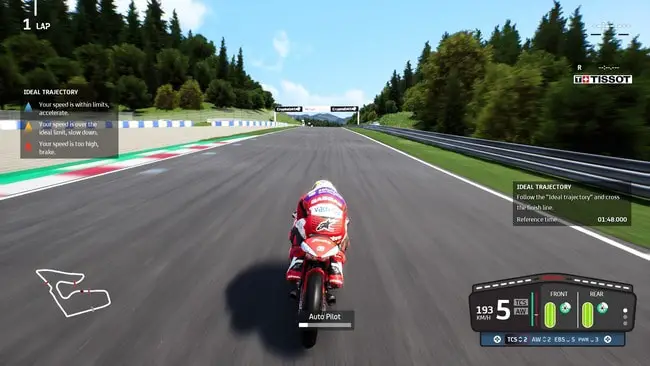
If you’re finding the MotoGP bikes too hard to control, move down to these slower class bikes. The career modes also allow you to start in these lower categories as well. The in game Tutorials we covered above also start you off on these lower class bikes, so you can compare and contrast and pick a bike class you’ll have the most fun with at your current skill level.
Tip #7 – Set The Correct AI Difficulty Level
Once you have got halfway decent with the bike handling to the point you can lap the tracks and race against the AI, it’s important to set the right difficulty level.
This varies game to game – see our MotoGP 22 AI Level tuning guide for a pointer – but any AI level you set must take into the account whether (and how many times) you fall off the bike during an average race. Since even with the easier Bike recovery disabled option (re-spawns you), it still costs you about 5-8 seconds of race time when you fall off.
Therefore you need to use an AI level that keeps you competitive and allows recovery from crashes, otherwise you’ll just be dead last and get frustrated. This means you may have to set a level somewhat slower than your raw pace when you get a lap right, until your consistency improves and you don’t fall off very much anymore.
Here’s a very rough guide:
- Total beginners (still falling off loads) – 30-40%
- Getting better – 50-60%
- Getting pretty consistent but occasional mistakes – 70%
- Pretty fast and very rare mistakes – 80%
- Seriously good players – 90%+
But you’ll need to test yourself against different AI levels on a Custom Championship mini season to tweak and find your own optimal level on each game.
Tip #8 – Practice On Some Easier Tracks
This is another huge thing to make these games easier and build confidence in the early stages. Practice on some of the easier tracks first. Don’t jump straight in at harder, tighter more twisty tracks with lots of gravel/grass run-off areas, where mistakes are punished more severely.
Instead, seek wider tracks with larger run off areas that mostly aren’t gravel traps, to build your confidence. See our guide on some of the easier tracks on the MotoGP games. Build yourself a small custom Championship season of these easier tracks first, and set a suitable AI level as covered above, so you can compete and have fun.
For example, the first 3 tracks on the official calendar since 2022 – Qatar, Mandalika (Indonesia) and Argentina (Termas) are pretty easy tracks to get stuck into. Qatar is really wide and has forgiving run off areas. Mandalika has a really simple layout and also minimal gravel traps. And Rio Hondo Termas is also a simple layout and massive wide track where you can run off and still recover. I also find Valencia a really easy and fun track to drive even though it’s twisty and narrow – the layout is really easy to visualize as you’re lapping the track, and it’s pretty easy to stay on the bike once you know the layout.
Some more difficult tracks to avoid for beginners are Portimao, Jerez, Texas and Malaysia. Save these until later when you’re more comfortable with the handling.
Tip #9 – Take A Rest & Come Back
This is something I’ve learned playing the F1 games, and applies to all sim racing games where there’s a learning curve with the handling. It’s often better to take short bursts at learning the game, but then take a rest and come back later.
Trying to grind the game for hours and hours at a time often isn’t the best approach, especially with really difficult MotoGP games like ’22. You’ll often find yourself getting annoyed and frustrated rather than having fun.
Taking a break often resets your muscle memory and when you reset and come back later on or the next day, you’ll often find you’re better and can nail something you were spending hours struggling with before.
Therefore, if you’re struggling with any MotoGP game, aim to practice no longer than 1-2 hours at any given time, before taking a break, resetting and coming back a few hours later or the next day. Chipping away at the game’s difficulty like this in smaller chunks is often the better approach than spending marathon sessions on the game and annoying yourself off it.
